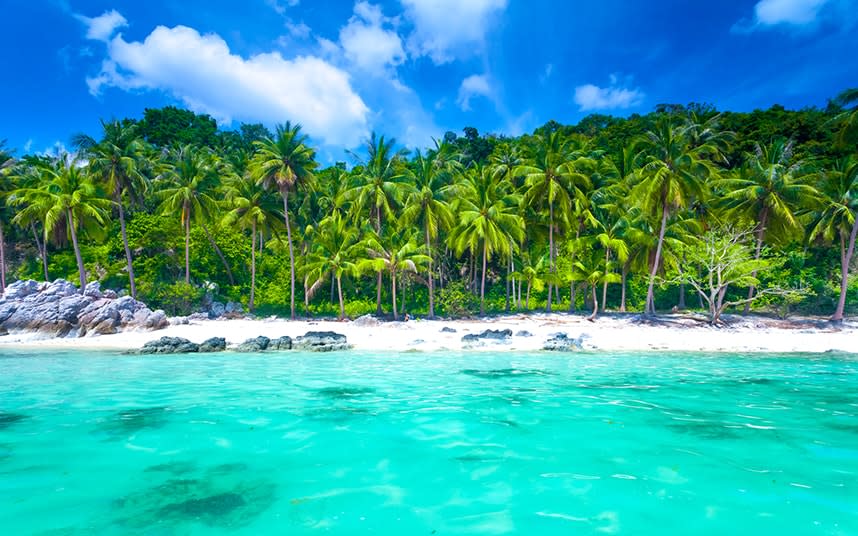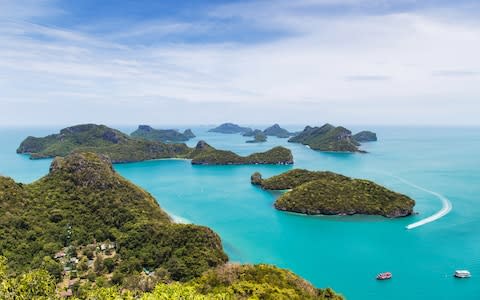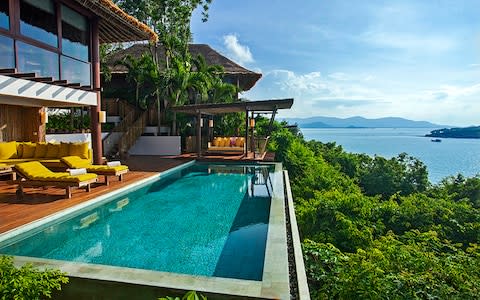How Koh Samui reinvented itself as Thailand's most luxurious holiday island

There can’t be many beach towns more odious than Koh Samui’s Chaweng. The best I can say for it, having visited numerous times over the years, is that it now has a Uniqlo. A branch of Hooters opened last summer, so... there’s that, too. But garish Chaweng, with its Irish theme pubs, fire juggling, and gangs of masseurs in orange boiler suits looking like graduates of an aggressive Guantánamo beauty therapy academy, is old news. The real Samui story is about modern luxury: secluded villas and fabulously styled new resorts a short cab ride away, all of them a rival to the best in the world.
The Ritz Carlton recently carved a fresh mega-property out of an old coconut plantation, a new private island resort is about to open just offshore, and funding is in place and plans under way for a superyacht marina. The sun is shining, the good times are rolling, and they have nothing to do with fluorescent face make-up and Full Moon Parties.
I absolutely love Koh Samui. It’s everything I adore about Thailand: the food, beaches, sunsets, friendliness and bang for buck. An hour’s short hop from Bangkok, it all feels so easy – like the modern equivalent of southern Spain in the late Seventies, but just 15 miles (25km) long and 13 miles (21km) wide. Development here hasn’t been without challenges – the restricted airlift at the tiny airport remains a stranglehold.

But developers continue to launch resorts: Cape Fahn (capefahnhotel.com) opens next month with 22 pool villas, offshore, a short boat ride from Choeng Mon Beach in the north-east. There’s also the Avani Sunset Coast Samui (minorhotels.com) coming to Taling Ngam Beach later this year, stretching the reach of resort life farther into the karaoke-free south-west parts of the island.
Some of the best places to stay right now are private villas, not resorts. Punch in your dates on Airbnb and you’ll find pages of white-walled glass pavilions with infinity pools – perfect for birthday parties ending in a zero. I stayed recently at Samujana (0066 77 423 465; samujana.com; from $650/£500 per night), a collection of new villas in a gated community in the north-east of the island, including the 1,808 sq metre (19,460 sq ft) Villa 24 (from $2,900 per night) that sleeps 16. Villa 30 (from $1,950 per night), where I stayed, is at the top of the hill. It has five bedrooms, a private cinema, and a roof deck with an infinity pool that has that increasingly elusive wow factor. I gasped when I first climbed the stairs and saw it, then at the end of my stay, felt that unique last-night melancholy as I watched the sunset smudge magenta around the neighbouring mountain.
There were a few language difficulties with my butler, particularly around taxi requests, but the in-house dining was good, and some decent wines were available for about a quarter of the hotel standard. Weirdly, when I arrived, there were half-deflated balloons floating in the indoor water feature, which remained there my whole stay. It felt like I was walking through a scene from one of the Hangover films every time I went to my room.

The most significant recent resort opening here is the Ritz Carlton (0066 77 915 777; ritzcarlton.com; rooms from 13,875 Thai baht/£325 per night), which launched last October. When I visited earlier this year, things were still being reshaped and tweaked – a steak restaurant was being built, as well as a pavilion on top of the hill for special events. They’d had some teething troubles with construction. Some things will take a while to hone and others, I suspect, will be rebuilt. Still, this is already a good resort as it stands, and the pleasure and luxury factors are high. The pool and beach areas are beautifully arranged, and the service is fawning; the rooms are huge, many with private pools, albeit with strangely under-sized bathtubs. The spa is an architectural stunner – with an infinity pool of its own, lined with tiered all-cabana beds that would be the focal point of many resorts – and when I went, I had it all to myself.
The most memorable aspect of the Ritz Carlton on Samui is the food – it has hands-down the best cooking I have experienced in any hotel on the island, from the canapés served at sunset with complimentary cocktails at the lobby lookout, to the ceviche at the pool bar and the Wagyu beef cheek massaman curry served in private booths after the delivery of banana-scented hand towels, overlooking the swimming reef. It’s all world class.
The food at the Ritz Carlton’s upstart, similarly Marriot-owned sibling, the W Koh Samui (0066 77 915 999; wkohsamui.com; from 20,250 THB/£475 per night), isn’t as successful. The dining at its Japanese fine dining restaurant, Namu, is as good as any Nobu, and the barbecued seafood and steak I had in my villa garden as part of the Hot Over the Coals private barbecue experience (from THB 5,700/£130 per couple) was agreeable, but the plate of chips I had on a floating tray in my private pool for lunch was an outrage. And yet, the beauty of the W – which has recently completed a resort-wide refurb – is that you eat those horrible chips while you’re swimming. Possibly naked.

It’s easy to dismiss the W as a brand that languishes in a retro haze of Carrie Bradshaw high heels and David Guetta mirrorballs, but their resorts are well executed, with design élan, fantastic beds and bathrooms, a sense of humour and mannered frivolity.
In Koh Samui’s W there are margaritas on draught, “Sweet Spot” fridges around the resort full of free Magnum ice creams, and huge inflatable flamingos in the pool. Instead of a bunch of bananas and a few biscuits, their welcome amenity in Samui incorporates a hammer and a cake iced with a depiction of a guest’s pet hate, gleaned from social media. Rival football clubs are prime targets. Chinese social media has made the W Koh Samui something of a sensation on the island – at one stage, 200 tourists a day were rocking up to take a selfie by the giant W at the edge of the pool and then immediately leaving. As a result, there’s now a $40 entrance charge to the lobby bar (recoupable as credit at the bar) if you aren’t a resident at the hotel.

If the W blends indulgence and irreverence, then the Anantara Bophut (0066 77 428 300; samui.anantara.com; rooms from 4,860 THB/£115 per night) and Six Senses (0066 77 245 678; sixsenses.com; rooms from $555 per night) offer a classic kind of luxury. The former is a groomed, family-friendly resort paradise, all set around an elongated strip of water full of lily pads and flowers, flanked by bowing palm trees. Repeat guests come here year after year, and I can see why.

The latter, refreshed in 2015, is castaway chic with eco-cred – giant bamboo rods stand along one side of the infinity pool, like a site-specific art installation, the villas feel like hidden-away, romantic, isolated jungle tree houses, and the resort recently scrapped plastic straws, in favour of hollow sticks of lemon grass. There’s also a farm for recycling waste and growing as much produce on-site as possible.
The last time I visited this Six Senses, they were fixated on molecular gastronomy at their much-photographed and self-explanatory Dining on the Rocks evening restaurant. Now it’s simpler, more delicious, but still fancy. Supper at the Anantara Bophut in its Full Moon restaurant, looking out across the pools and ocean, is also fine dining territory. I found it eccentric, and amusingly so. To emphasise the luxury aspect of proceedings, a salt sommelier wheels their extensive wares over on a trolley before another member of staff offers a box with numerous ornate steak knives. Take your pick. Menaced by novelty, I wondered what they could do next, only to turn around to make eye contact with a waiter brandishing a comically oversized pepper grinder.

For all the upgrades and slick tricks, there is still the old Samui that I love as much as the luxury. The seasonal nature of the island means that it’s virtually impossible for high-end restaurateurs to get a foothold – in autumn, when it’s still 80F (27C), resort occupancies drop as low as 50 per cent, and the locals won’t pay tourist prices. There are, however, those countless thrifty shacks serving myriad noodle dishes and whole steamed sea bass with lime and chilli, and where a vegetable curry will still cost you around £2. One of my favourite dinners was at Pui Relax (0066 87 896 6357), a 15-minute walk from Samujana. It was laid-back, delicious, and totally Thai.
After a week of the soft soap from international resorts and their interpretation of “spicy”, the larb gai and papaya salad incinerated my tongue. When I went back again, I made sure I asked for “medium”. But I went back. Twice. I look forward to going back again and again.
Essentials
British Airways (britishairways.com) flies daily from London to Bangkok, from £549 return; Bangkok Airways (bangkokair.com) flies from Bangkok to Koh Samui, from 4,190 THB (£98) one way.

